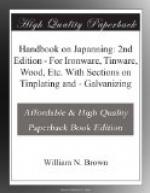[Illustration: Fig. 9—Japanning and Enamelling Oven For Bedstead, Ironmongery, Cash-box, and Lamp Factories.]
[Illustration: Fig. 10.—Japanning and Enamelling Stove for parts of Sewing Machines.]
It will be seen from the various illustrations that the articles to be treated are absolutely isolated from actual contact with the fire or the fire gases and other impurities which must be an objection to all methods of heating by means which are not of a purely mechanical nature. This principle not only recommends itself as scientifically correct and suited to the purpose in view, but is also a very simple and practical one. It affords the means of applying the heat at the point where it is required to do the work without unduly heating parts where heat is unnecessary; it secures absolute uniformity, perfect continuity, and the highest possible fuel economy.
[Illustration: Fig. 11.—Japanning and Enamelling Stove for Iron-Bedsteads and Household Ironmongery with Truck on Rails.]
[Illustration: Fig. 12—Permanent Japanning and Enamelling Stove for Kitchen Utensils built in Masonry.]
The nature of the work to be executed in the different classes and various sizes of stoves vary so greatly and indefinitely that only by careful attention to the special requirements of each case, on the part of the designers and constructors, is it possible to obtain the most satisfactory results.
The arrangement of fixing the pipes round the lower walls of the room in this form of stove is somewhat cumbersome, but in a roomy stove this slight drawback is not felt quite so much. However, it seems a good principle to leave every inch of internal space available for the goods to be enamelled or japanned, This principle is carried out to the letter in the other form of stoves described and illustrated in the sequel.
The figure shows a section through single chamber japanning and enamelling oven heated by hot-water pipes (steel) closed at both ends and partially filled with water which always remains sealed up therein, and never evaporates until the pipes require to be refilled.
This stove may be heated (1) by hot-water pipes (iron), (2) by super-heated water, (3) by steam, but only to 80 deg. C. The different compartments may be heated to uniform or to different temperatures with hot water; the stoke-hole is at the side and thus quite separated from the stove proper.
The ovens must be on the ground floor, so that the super-heated steam from the basement may be available.
The great drawback to the use of gas for heating japanning and enamelling stoves is the great cost of coal gas.
[Illustration: Fig. 13.—Portable Gas Heated Japanning and Enamelling Stove fitted with Shelves, Thermometer, etc.]




